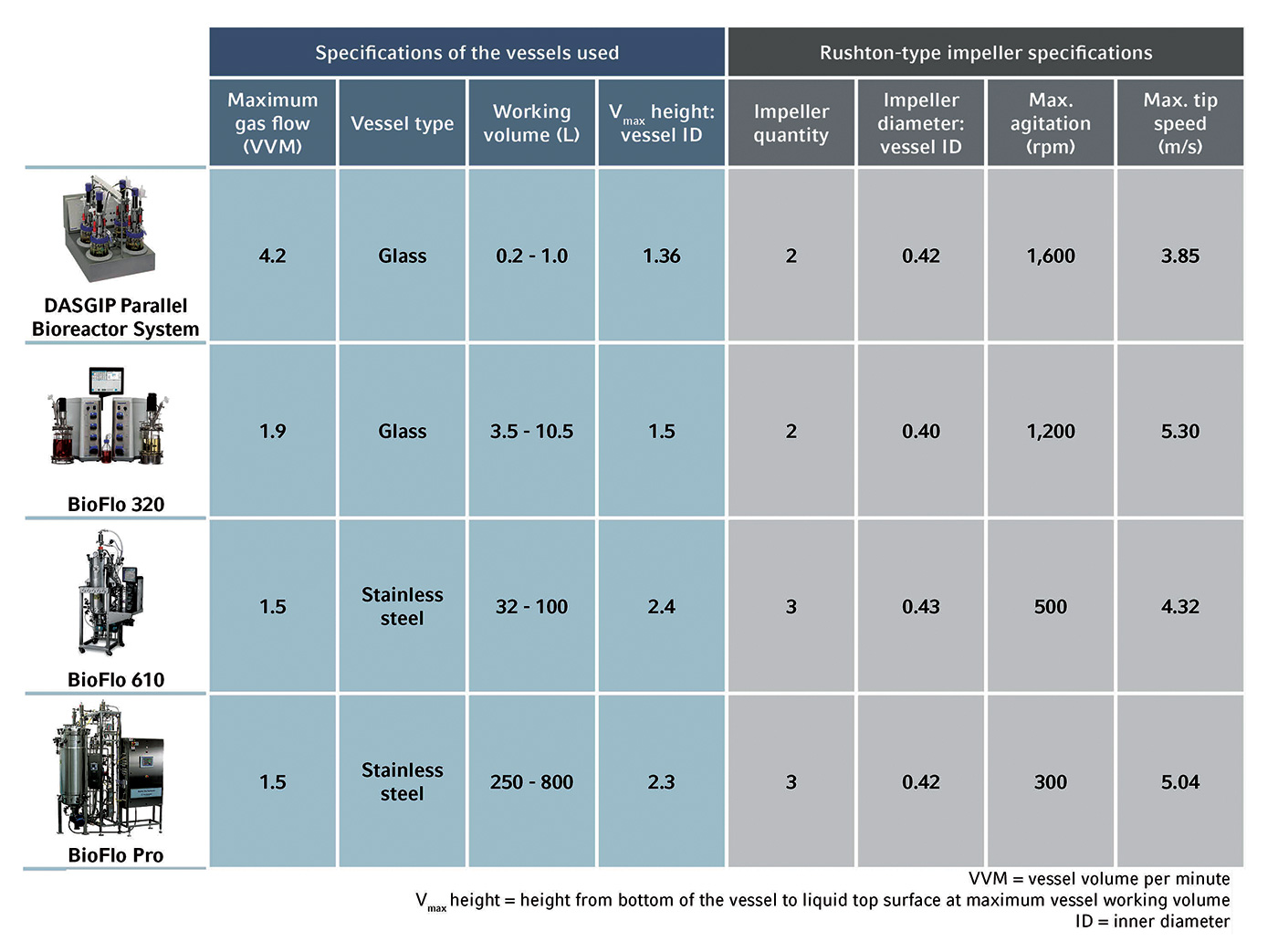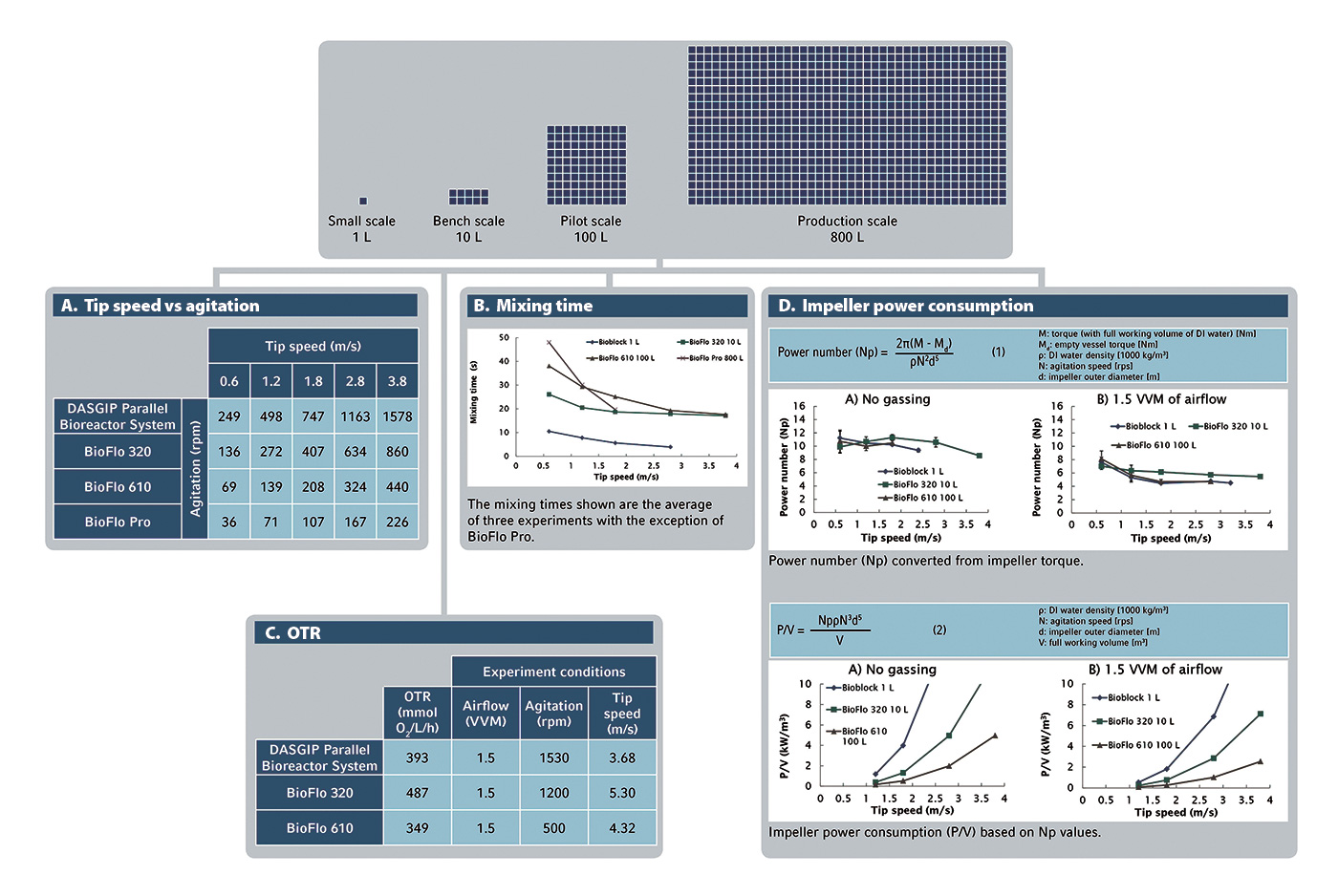May 1, 2016 (Vol. 36, No. 9)
Bin Li Ph.D. Bioengineer Eppendorf
Ulrike Becken Scientific Communication Manager Eppendorf AG Bioprocess Center
Ma Sha Ph.D. Director of Technical Applications Eppendorf
Fermentation Systems for Bioprocess Scale-up from Small to Pilot/Production
Commercial production of biologics
requires development of a fermentation process that is time- and cost-efficient, and highly reliable. In an early stage of development, many process parameters are evaluated at small or bench scale to find the optimal conditions.
The small- to bench-scale processes, at typical working volumes of 1 to 10 L, are then scaled up to pilot and production scale at more than 100 L. Critical bioprocess parameters have to be reproduced at each scale, to keep the product yield and quality constant while increasing the manufacturing volume.
For simplification of process scale-up, researchers need a portfolio of fermentation systems that provide scalable bioprocess parameters to allow yield and functional reproducibility at each scale.
To characterize the scale-up capabilities of the Eppendorf fermenter portfolio, we investigated engineering parameters critical for scale-up, including vessel and impeller geometry, tip speed, mixing time, oxygen transfer rate (OTR), and impeller power number (Np, also known as Newton Number, Ne).
Eppendorf fermentation systems are available in autoclavable, single-use, and sterilize-in-place (SIP) vessel designs. They cover a wide range of working volumes, from less than 1 L to as much as 2,400 L. We used four Eppendorf fermentation systems to represent different scales (Figure 1).
A DASGIP® Parallel Bioreactor System with a Bioblock was selected as the small-scale system. The Bioblock is capable of temperature control in up to four vessels. The system used glass vessels of 1 L working volume, equipped with optional GPI-100 baffles.
For bench scale, we used a BioFlo® 320 bioprocess control station with a 10 L stainless steel dished-bottom glass vessel with baffles. We carried out pilot-scale experiments in a BioFlo 610 mobile fermenter, with a 100 L SIP stainless steel vessel with baffles. To evaluate the process at production scale, we used a BioFlo Pro fermenter equipped with an 800 L SIP stainless steel vessel that also has baffles (Figure 1).

Figure 1. Eppendorf fermentation systems from small- to production-scale. Specifications of vessels and impellers used in the presented set-up.
Tip Speed and Mixing Time
Maintaining a constant impeller tip speed is one of the most common strategies for scale-up, especially for cultures like mammalian cell lines or stem cells that are sensitive to shear force damage. Consistent impeller tip speeds are known to provide relatively constant levels of shear force with different size impellers. We evaluated tip speed-based bioprocess scalability between the various Eppendorf systems. All of them allow achieving tip speeds of 0.6, 1.2, 1.8, 2.8, and 3.8 m/s by adjusting the rate of agitation (Figure 2A).
However, a constant tip speed-based scale-up may result in reduced mixing performance in larger vessels, and adjustments might be necessary to maintain yields at higher volumes.
Adjustments for differences in mixing performance are based on matching the mixing times between the larger vessels and the smaller ones. We conducted mixing time studies using the pH sensor method described by Zadghaffari et al., (Iranian Journal of Chemical Engineering; 2008, 5:12–22). pH sensors were placed near the top and bottom of the liquid, and their readings were averaged.
The mixing time is represented as time taken to reach 95% pH equilibrium after the addition of 4 N NaOH solution to the vessel. Our results showed that all four systems tested are capable of rapid mixing (Figure 2B).

Figure 2. Strategies for bioprocess scale-up using the Eppendorf fermentor portfolio.
Oxygen Transfer Rate
In a bioprocess, the oxygen transfer rate is the rate at which oxygen passes from the air to the liquid in the vessel. Since oxygen is often the limiting factor during an aerobic fermentation, the OTR is often used as a benchmark for fermenter performance and it is important to make sure that all equipment that is used in a process development cycle has similar OTR capabilities. Otherwise, it might be difficult to replicate a small or bench-scale success at production scale.
We conducted the OTR measurements in this study using the sodium sulfite oxidation method. As shown, all systems supported high oxygen transfer rates, indicating excellent design and suitability for aerobic fermentation (Figure 2C).
The previously mentioned impeller power number (Np) is a dimensionless quantity associated with different types of impellers. During bioprocess scale-up, the Np is commonly used to calculate the impeller power consumption per liquid volume (P/V [W/m3]). Maintaining constant P/V between vessels is another of the most accepted strategies for scale-up.
Np can be calculated from the impeller torque using equation (1) in Figure 2. The impeller torque was experimentally determined from the direct-drive motor attached to the impeller, by using a rotational torque sensor.
Since typical fermentation experiments are conducted under high gassing conditions, we obtained Np under 1.5 vessel volume per minute (VVM) airflow as well as under “no gassing” conditions. The analysis revealed that the Np varied slightly at different tip-speeds (Figure 2).
However, as the values were very similar to each other, the average can be considered a constant when scaling up using the Eppendorf family of fermenters. The final rated value of P/V can be calculated from the Np using equation (2) (Figure 2D).
100-Fold Scalable
As shown above, the Eppendorf portfolio offers a comprehensive set of fermentation systems that are suitable for various scale-up strategies. The impellers’ power numbers remained virtually constant from 1 L to 100 L fermentation vessels at tip speeds above 1 m/s.
It is possible, by maintaining a constant impeller power consumption per unit volume between vessels, to scale-up from DASGIP Parallel Bioreactor Systems equipped with 1 L vessels to the 10 L scale controlled with the BioFlo 320, and on up to a working volume of 100 L, using the BioFlo 610.
The evaluated stirred-tank fermenters, from benchtop to production scale, are similar in geometry and proportions (Figure 1). All four systems are capable of rapid mixing, and support the delivery of high OTRs, making them ideally suited for the scaling of high-density fermentation.
Bin Li, Ph.D., is a bioengineer, Ulrike Becken, Ph.D. ([email protected]), is a scientific communication manager, and Ma Sha, Ph.D., is a director of technical applications at Eppendorf.







